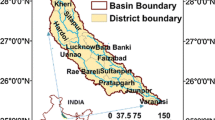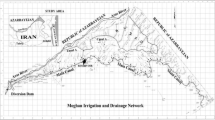Abstract
Agriculture sector is the largest water consumer among all known demands for water. Having measured the direct water consumption is only one indicator of water supplied to this sector, while the virtual water used during the production process can also stand for a large share of water being indirectly used. Therefore, considering the virtual water consumption can be a defining factor to optimize crop cultivation accordingly. To this end, this research is structured to practice optimizing crop cultivation area in Golestan province of Iran, with the objectives of maximizing green water use and conservation of water resources while maintaining the farmers’ profit through the virtual water trade approach using the Grasshopper optimization algorithm. The crop water demand (CWD), blue virtual water (BVW), green virtual water (GVW), and total virtual water (TVW) of 21 agricultural products were calculated in Seven categories including cereals, industrial products, beans, vegetable, cucurbits, feed plants, and rice for 13 major counties of the Golestan province for the period of 2008–2016. The optimization model was implemented for the 2015 data. Results showed that in most counties the area under cereals cultivation was declined sharply after the optimization and other products such as bean, feed plants and vegetables, etc. replaced it. In addition, in the whole province, the area under cultivation of cereal crops and rice decreased by 93% and 36%, respectively; while the area under bean and vegetables cultivation increased by 949.22% and 111.1%, respectively. The optimization process increased the farmers’ profit by 46.15%, while decreasing the export of blue virtual water by 323.76 mm3 (81.6%). Results, proved the effectiveness of the Grasshopper optimization algorithm in this application and its strength in dealing with multi-objective models especially in water resources engineering. It is also concluded that the virtual water trade, being a key factor in the plant factories profitability, can be optimized effectively to benefit farmers through managing the crop cultivation theme according to the regional status of water-food-energy nexus.






Similar content being viewed by others
Availability of data and materials
Data not available.
References
Ababaei B, Etedali HR (2017) Water footprint assessment of main cereals in Iran. Agric Water Manag 179:401–411
Abu-Sharar TM, Al-Karablieh EK, Haddadin MJ (2012) Role of virtual water in optimizing water resources management in Jordan. Water Resour Manag 26(14):3977–3993
Allen RG, Pereira LS, Raes D, Smith M (1998) Crop evapotranspiration guidelines for computing crop water requirements. FAO Irrigation and Drainage Paper 56, Rome
Ashutoshrath R, Sudarsanbiswal B, Samantaray S, Swain PC (2017) Derivation of optimal cropping pattern in part of hirakud command using cuckoo search. Mater Sci Eng 225(1):012068
Chen SY (1994) System fuzzy decision theory and application. Dalian University of Technology Press, Dalian, pp 23–24
Falkenmark M, Rockstrom J (2004) Balancing water for humans and nature: the new approach to ecohydrology. Earthscan, London, pp 74–89
FAO (2013) CROPWAT Model. Food and Agriculture Organization, Rome. www.fao.org/nr/water/inforesdatabasescropwat.html
Fraiture CD, Cai X, Amarasinghe U, Rosegrant M, Molden D (2004) Does international cereal trade save water? The impact of virtual water trade on global water use. Research Report No.4. IWMA, Colombo, Srilanka.
Hoekstra AY, Hung PQ (2002) Virtual water trade: a quantification of virtual water flows between nations in relation to international crop trade. Value of Water Research Report Series No. 11. UNESCO – IHE, Delft, 49(11): 203–209.
Hoekstra AY, Chapagain AK, Aldaya MM, Mekonnen MM (2011) The water footprint assessment manual: setting the global standard. Earthscan, London
Karandish F, Salari S, Darzi-Naftchali A (2015) Application of virtual water trade to evaluate cropping pattern in arid regions. Water Resour Manage 29:4061–4074. https://doi.org/10.1007/s11269-015-1045-4
Liang MS, Wang ZZ (2010) Optimal regional agricultural planting structure under virtual water strategy. Trans CSAE 26(S1):130–133
Mohammadrzapour o, Kisi o, pourahmad F, (2018) Fuzzy c-means and K-means clustering with genetic algorithm for identification of homogeneous regions of groundwater quality. Neural Comput Appl. https://doi.org/10.1007/s00521-018-3768-7
Mohammadrezapour O, Yoosefdoost I, Ebrahimi M (2019) Cuckoo optimization algorithm in optimal water allocation and crop planning under various weather conditions (case study: Qazvin plain, Iran). Neural Comput Appl 31:1879–1892. https://doi.org/10.1007/s00521-017-3160-z
Ren DP, Liu PB, Li HA (2009) Agricultural structure adjustment in Beijing under the virtual water strategy. Trans CSAE 25(S1):11–16
Sarmi S, Mirjalili S, Lewis A (2017) Grasshopper optimisation algorithm: theory and application. Adv Eng Softw 150:30–47
Shreedhar R, Ghandrashekarayya GH, Shetty GG (2015) Optimization of cropping pattern using linear programming model for Markandeya command area. Int J Sci Eng Res 6(9):1311–2132
Su X, Li J, Singh VP (2014) Optimal allocation of agricultural water resources based on virtual water subdivision in Shiyang River Basin. Water Resour Manage 28:2243–2257. https://doi.org/10.1007/s11269-014-0611-5
Sun SK, Wu PT, Wang YB, Zhao XN (2013) The virtual water content of major grain crops and virtual water flows between regions in China. J Sci Food Agric 93:1427–1437
Zeynali MJ, Shahidi A (2018) Performance assessment of Grasshopper optimisation algorithm for optimizing coefficients of sediment rating curve. AUT J Civil Eng 2(1):31–40
Acknowledgements
Omolbani Mohammadrezapour would like to thank the University of Zabol for financing this project under the Grant Number of IR-UOZ-GR-0014
Author information
Authors and Affiliations
Corresponding author
Ethics declarations
Conflict of interest
There is no conflict of interest among the authors.
Additional information
Publisher's Note
Springer Nature remains neutral with regard to jurisdictional claims in published maps and institutional affiliations.
Rights and permissions
Springer Nature or its licensor (e.g. a society or other partner) holds exclusive rights to this article under a publishing agreement with the author(s) or other rightsholder(s); author self-archiving of the accepted manuscript version of this article is solely governed by the terms of such publishing agreement and applicable law.
About this article
Cite this article
Mohammadrezapour, O., Bazi, E., Zeynali, M. et al. Optimization of crop cultivation area using Grasshopper algorithm with virtual water perspectives. Sustain. Water Resour. Manag. 9, 82 (2023). https://doi.org/10.1007/s40899-023-00839-w
Received:
Accepted:
Published:
DOI: https://doi.org/10.1007/s40899-023-00839-w




